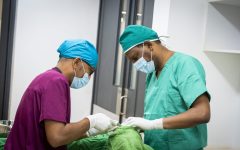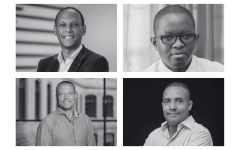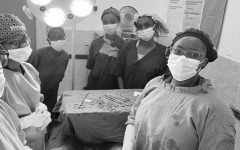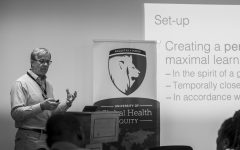The Essence of Giving Back: Dr. Kelsey Ripp’s Quiet Contribution in One Health
September 16, 2025 2025-09-19 12:25The Essence of Giving Back: Dr. Kelsey Ripp’s Quiet Contribution in One Health
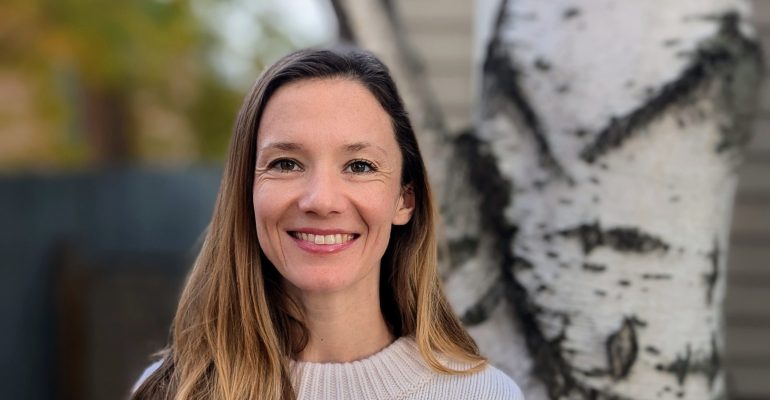
The Essence of Giving Back: Dr. Kelsey Ripp’s Quiet Contribution in One Health
At first glance, “One Health” can sound abstract, like an academic term that lives on slides and in strategy documents. For Dr. Kelsey Ripp, Assistant Professor in UGHE’s School of Medicine and the Centre for One Health, it’s the opposite: One Health is a way of seeing, a practice of attention. It is the recognition that people, animals, and environments share and shape one another’s health everyday. Teaching that worldview, she says, is how she gives back, both to her students and to the communities they will serve.
“I believe teaching about the connection between animal, environmental, and human health helps students improve patient care and advocate for holistic health approaches,” she says. “Medical school is a crazy time where you learn so much, and transition from being a student reading books to taking care of a patient who sometimes literally puts their life in your hands, in an astoundingly short period of time.”
For Dr. Kelsey, One Health gives students a wider lens for that transition, helping them link symptoms to stories and diagnoses to the living conditions that make people well, or unwell.
Learning from the land and its people
Part of Dr. Kelsey’s perspective comes from her clinical work with the Alaska Native Tribal Health Consortium, a health system run by and for Indigenous communities. She works primarily in the hospital and has also served in clinic settings in remote villages. The experience has sharpened her understanding of how intimately health is tied to place.
“I cannot adequately speak for this population, as I am not Alaska Native,” she says carefully. “But I am aware that these communities have strong connections with their land, which includes the animals on it and the environment they share.” That connection is not a metaphor; it is memory, identity, and survival. She recalls a patient living with severe depression who traced part of his suffering to how quickly the land around his village was changing. Intensive mining had altered the landscape so drastically that it no longer felt like home, no longer looked like the place where his ancestors had lived for thousands of years. Elsewhere, entire villages are planning to relocate because of sea-level rise.
“These environmental and social factors are playing out in the background,” Dr. Ripp says, “and fundamentally affect the way and ability of people to access medical care.”
Working with rural communities in Rwanda has reinforced the same lesson. Whether in the highlands of the Northern Province or along Alaska’s coasts, people live closely with their environments and with domestic or wild animals. When the environment changes, health changes—sometimes suddenly, often silently.
“Traditional biomedical training focuses on artificial boundaries that don’t exist in the real world,” she says. “Our future healthcare leaders need to think across these boundaries from day one.”
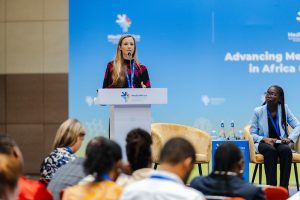
Teaching the connection
At UGHE, Dr. Kelsey brings this orientation into lecture halls, case discussions, and bedside teaching. She doesn’t only teach medicine, she teaches connection. The one between the land and our lungs, between livestock and livelihoods, between water access and wound healing, between what doctors know and what they must still learn from patients themselves.
“I’ve always been interested in the ways we humans impact our environment and how our environment impacts us,” she reflects. “Much of what we learn as medical students focuses on the biology of the patient in front of us, but the ecological and social context in which that patient lives is critical.”
Her courses ask students to practice taking a “One Health history,” adding questions about work, animals, housing, travel, water and sanitation, and environmental exposures to the standard medical interview. The goal isn’t to collect more data for its own sake; it’s to surface the real-world drivers of disease and to open the door to prevention, advocacy, and dignified care.
Dr. Kelsey keeps a quiet pride when she speaks about her students’ growth. The stories often reach her secondhand. One, though, has stayed with her. A young man had been admitted with advanced lung disease, dependent on oxygen. A student, using the One Health history, dug deeper into his work life and learned he had spent years in mining without adequate protective equipment. That context reframed everything, his symptoms, exam, and imaging, pointing to silicosis, a preventable lung disease associated with silica exposure.
“The diagnosis mattered,” she says, “but what made me even more proud was what came next.” The students advocated for the patient to receive a home oxygen concentrator through Inshuti Mu Buzima (IMB), allowing him to leave the hospital and return to his family. It was a small victory inside a larger story about occupational safety and social protection, but it showed the overlap between One Health and social medicine in practice.
Giving back, quietly and consistently
Ask Dr. Kelsey what “giving back” looks like, and she won’t talk about podiums or plaques. She talks about attention. About showing up prepared. About teaching students to ask one more question, to listen a bit longer, to look beyond the presenting complaint.
“Teaching is how I give back,” she says simply. “If students leave my class ready to see connections, and to treat those connections as clinically relevant, then they will care for patients more completely. They’ll be better advocates for healthier environments, safer workplaces, and communities that can thrive.”
UGHE’s approach to One Health is not an elective or a footnote; it is part of how future clinicians and public health leaders are formed. Dr. Kelsey’s work sits squarely in that mission.
“The Essence of Giving Back” is a blog series that explores both the big and small ways our community is making a difference. At UGHE, we believe giving back is more than a charitable act, it is a philosophy of service, empathy, and responsibility. It involves contributing time, effort, or resources to a cause or community without the expectation of personal gain. Giving back is about creating a positive impact and uplifting others, often through small, intentional acts of kindness and support. Stay tuned for the following episodes.
Related Posts
912Rwanda is Saving More Lives in the Golden Hour
Search
Archives
- December 2025
- November 2025
- October 2025
- September 2025
- August 2025
- July 2025
- June 2025
- February 2025
- November 2024
- October 2024
- September 2024
- August 2024
- July 2024
- May 2024
- April 2024
- March 2024
- February 2024
- January 2024
- December 2023
- November 2023
- October 2023
- September 2023
- August 2023
- July 2023
- June 2023
- May 2023
- April 2023
- March 2023
- February 2023
- January 2023
- December 2022
- November 2022
- October 2022
- September 2022
- August 2022
- July 2022
- June 2022
- May 2022
- April 2022
- March 2022
- February 2022
- January 2022
- December 2021
- November 2021
- October 2021
- September 2021
- August 2021
- July 2021
- June 2021
- May 2021
- April 2021
- March 2021
- February 2021
- January 2021
- December 2020
- November 2020
- October 2020
- September 2020
- August 2020
- July 2020
- June 2020
- May 2020
- April 2020
- March 2020
- February 2020
- January 2020
- December 2019
- November 2019
- October 2019
- September 2019
- August 2019
- July 2019
- May 2019
- April 2019
- March 2019
- February 2019
- January 2019
- December 2018
- November 2018
- October 2018
- September 2018
- August 2018
- June 2018
- May 2018
- April 2018
- March 2018
- February 2018
- January 2018
- December 2017
- November 2017
- October 2017
- September 2017
- August 2017
- July 2017
- June 2017
- May 2017
- April 2017
- February 2017
- January 2017
- December 2016
- November 2016
- October 2016
- September 2016
- August 2016
- July 2016
- May 2016
- February 2016
- October 2015
- September 2015
- June 2015


